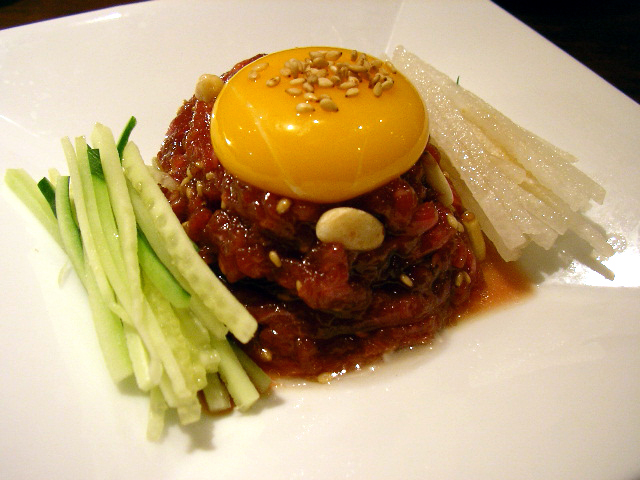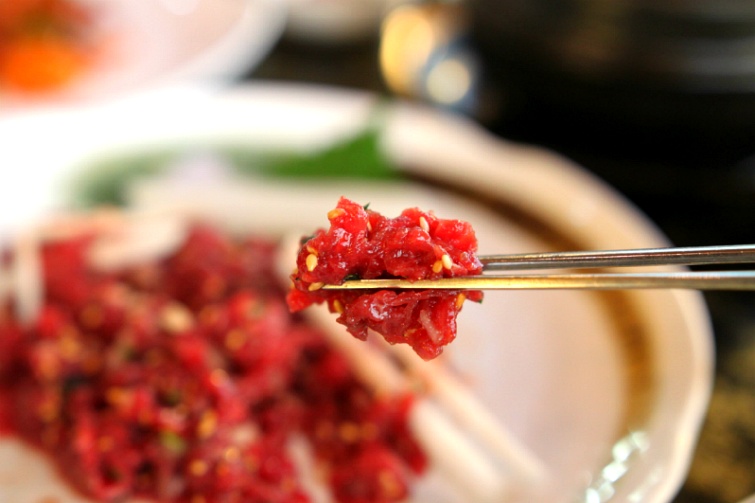Yukhoe on:
[Wikipedia]
[Google]
[Amazon]
''Yukhoe'' ( ko, 육회 ) is a raw meat dish in Korean cuisine. It is most commonly made of beef but it can come in various kinds and cuts of meat.
''Yukhoe'' literally means 'raw (''hoe'', ) meat (''yuk'', )'. Therefore, in the strictest context, the term designates any dish of raw meat cut up for consumption without the marinade. But colloquially ''yukhoe'' means a dish of marinated raw beef slices. Though relatively rare to find these days, ''yukhoe'' can come in all kinds of meat. Yukhoe made of other meats will mention the source of the meat, for instance, a ''kkwong-yukhoe'' is made of
at Doosan Encyclopedia. Korean pear, raw egg yolk, and pine nuts are commonly used as garnishes. It is similar to a Western tartare or a Levantine kibbeh nayeh. ''Yukhoe'' is also made with other cuts of beef, such as
at Doosan Encyclopedia.
 According to the 19th century cookbook ''
According to the 19th century cookbook ''
at Korea Britannica.

File:Yukhoe_in_korea.jpg
File:Korean cuisine yukhoe beef sashimi.jpg
Malgogi-yukhoe.jpg, ''Malgogi-yukhoe'' ( horse meat tartare)
Malgogi-yukhoe 2.jpg, ''Malgogi-yukhoe'' (horse meat tartare)
San-nakji_Korea_Seoul.webm, Beef tartare served with chopped live octopus (
Recipe for ''yukhoe''
at Daum
Recipe for ''yukhoe''
{{Webarchive, url=https://web.archive.org/web/20100717131524/http://www.chow.com/recipes/11581-yuk-hoe-seasoned-raw-beef , date=2010-07-17 at Chow.com
Mangchi's Recipe of ''yukhoe'' Korean style tartare
at Maangchi.com
Recipe for ''yukhoe''
at Souschef.co.uk Korean royal court cuisine Raw beef dishes Korean beef dishes
pheasant
Pheasants ( ) are birds of several genera within the family Phasianidae in the order Galliformes. Although they can be found all over the world in introduced (and captive) populations, the pheasant genera native range is restricted to Eurasia ...
, and a ''mal-yukhoe'' is made of horse meat.
''Yukhoe'' is most commonly made of lean cuts such as an eye of round, but more tender cuts of a beef can also be used. The beef is cut into thin strips while removing the fat, then it is seasoned with salt, sugar, sesame oil, pepper, and garlic.Yukhoeat Doosan Encyclopedia. Korean pear, raw egg yolk, and pine nuts are commonly used as garnishes. It is similar to a Western tartare or a Levantine kibbeh nayeh. ''Yukhoe'' is also made with other cuts of beef, such as
liver
The liver is a major organ only found in vertebrates which performs many essential biological functions such as detoxification of the organism, and the synthesis of proteins and biochemicals necessary for digestion and growth. In humans, it ...
, kidney
The kidneys are two reddish-brown bean-shaped organs found in vertebrates. They are located on the left and right in the retroperitoneal space, and in adult humans are about in length. They receive blood from the paired renal arteries; blo ...
, heart
The heart is a muscular organ in most animals. This organ pumps blood through the blood vessels of the circulatory system. The pumped blood carries oxygen and nutrients to the body, while carrying metabolic waste such as carbon dioxide to t ...
, '' cheonyeop'', or '' yang'', in which case the dish is called ''gaphoe'' (, ). The ingredients are thoroughly cleaned and salted, then rinsed and dried to remove unpleasant odors. ''Gaphoe'' is usually seasoned with sesame oil, salt and pepper, and is served with a spicy mustard sauce.Gaphoeat Doosan Encyclopedia.
History
 According to the 19th century cookbook ''
According to the 19th century cookbook ''Siuijeonseo
''Siuijeonseo'' () is a Korean cookbook compiled in the late 19th century. The author is unknown but is assumed to be a lady of the yangban (nobility during the Joseon dynasty) class in Sangju, North Gyeongsang Province. In 1919, as Sim Hwanjin w ...
'' (, ), thin slices of tender beef are soaked to remove blood before being finely shredded. The shredded beef is then marinated in a mixed sauce of chopped spring onion
Scallions (also known as spring onions or green onions) are vegetables derived from various species in the genus ''Allium''. Scallions generally have a milder taste than most onions and their close relatives include garlic, shallot, leek, chi ...
, minced garlic, pepper, oil, honey
Honey is a sweet and viscous substance made by several bees, the best-known of which are honey bees. Honey is made and stored to nourish bee colonies. Bees produce honey by gathering and then refining the sugary secretions of plants (primar ...
, pine nuts
Pine nuts, also called piñón (), pinoli (), pignoli or chilgoza (), are the edible seeds of pines (family Pinaceae, genus ''Pinus''). According to the Food and Agriculture Organization, only 29 species provide edible nuts, while 20 are trade ...
, sesame, and salt. Its dipping sauce, '' chogochujang'' (), chili pepper
Chili peppers (also chile, chile pepper, chilli pepper, or chilli), from Nahuatl '' chīlli'' (), are varieties of the berry-fruit of plants from the genus ''Capsicum'', which are members of the nightshade family Solanaceae, cultivated for ...
condiment mixed with vinegar
Vinegar is an aqueous solution of acetic acid and trace compounds that may include flavorings. Vinegar typically contains 5–8% acetic acid by volume. Usually, the acetic acid is produced by a double fermentation, converting simple sugars to eth ...
and sugar) can be altered to taste, with pepper or honey.Yukhoeat Korea Britannica.
Varieties
Beefs
Other meat

Health concerns
Meat in Korean cuisine has highly detailed classifications regarding freshness,quality
Quality may refer to:
Concepts
*Quality (business), the ''non-inferiority'' or ''superiority'' of something
*Quality (philosophy), an attribute or a property
*Quality (physics), in response theory
* Energy quality, used in various science discipl ...
, and part differentiation for specific cooking methods. Since ''yukhoe'' uses raw beef, freshness is the most important criterion, and for this typical dish's beef it is recommended to use no more than one day after defrosting, and traditionally should not be aged more than one day after slaughtering. Regular Korean ''yukhoe'' customers are often patrons of trusted restaurants or butcher's shops which have well-known, high-quality beef distributors.
Since 2004, the Korean Government has run the Beef Traceability System. This system requires ID numbers with the age of the beef animal of origin, supplier, distributor, the beef's grade, and butchering date and originating butchery. Most of the good beef restaurants in Korea list their beef's information on the wall. Also, butcher shops post signs saying, "new beef coming day" ( ''so deureoyoneun nal''): these words have become a well-known idiom in Korea and it means newly butchered beef supplied at the day.
Raw beef can be contaminated with pathogenic bacteria, with enterohemorrhagic ''E. coli'' (O111 or O157:H7) being of particular concern. Only by the freshness of beef can the risk be reduced.
Japan 2011 incident
In April and May 2011, five people died and more than 35 people were hospitalised after eating ''yukke'' (Japanese spelling) made from beef not designated for raw consumption in various branches of a ''bulgogi
''Bulgogi'' (불고기; ; from Korean ''bul-gogi'' ), literally "fire meat", is a ''gui'' (구이; Korean-style grilled or roasted dish) made of thin, marinated slices of meat, most commonly beef, grilled on a barbecue or on a stove-top grid ...
'' restaurant chain in Toyama and Kanagawa
is a prefecture of Japan located in the Kantō region of Honshu. Kanagawa Prefecture is the second-most populous prefecture of Japan at 9,221,129 (1 April 2022) and third-densest at . Its geographic area of makes it fifth-smallest. Kanagaw ...
prefectures, Japan, with enterohemorrhagic '' E. coli'' bacteria found in many of the cases.
On October 22, 2011, the last hospitalized victim, a 14-year-old boy, died of hemolytic-uremic syndrome. The final death toll of the incident was five people. As a result, the MHLW developed regulations for trimming raw beef to remove surface contamination, and the Japanese Ministry of Health, Labor and Welfare (MHLW) developed new regulations to require cooking the surface 1 cm deep to further reduce contamination. However, since the dimensions of individual pieces of yukhoe/yukke are quite smaller than 1 cm cubes, preparing the beef to this standard would cook it all the way through, and it would no longer be yukhoe/yukke.
Gallery
San-nakji
''San-nakji'' () is a variety of ''hoe'' (raw dish) made with long arm octopus (''Octopus minor''), a small octopus species called ''nakji'' in Korean and is sometimes translated into "baby octopus" due to its relatively small size compared to ...
).
See also
*'' Hoe'' * Korean royal court cuisine *List of beef dishes
A ''list'' is any set of items in a row. List or lists may also refer to:
People
* List (surname)
Organizations
* List College, an undergraduate division of the Jewish Theological Seminary of America
* SC Germania List, German rugby unio ...
*''Siuijeonseo
''Siuijeonseo'' () is a Korean cookbook compiled in the late 19th century. The author is unknown but is assumed to be a lady of the yangban (nobility during the Joseon dynasty) class in Sangju, North Gyeongsang Province. In 1919, as Sim Hwanjin w ...
''
*Steak tartare
Steak tartare or tartar steak is a dish of raw ground (minced) beef. It is usually served with onions, capers, mushrooms, pepper, Worcestershire sauce, and other seasonings, often presented separately, to be added to taste. It is often ser ...
*'' Kitfo''
References
External links
*Recipe for ''yukhoe''
at Daum
Recipe for ''yukhoe''
{{Webarchive, url=https://web.archive.org/web/20100717131524/http://www.chow.com/recipes/11581-yuk-hoe-seasoned-raw-beef , date=2010-07-17 at Chow.com
Mangchi's Recipe of ''yukhoe'' Korean style tartare
at Maangchi.com
Recipe for ''yukhoe''
at Souschef.co.uk Korean royal court cuisine Raw beef dishes Korean beef dishes